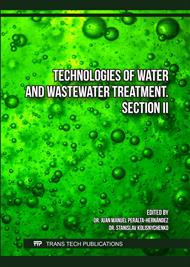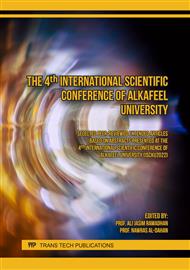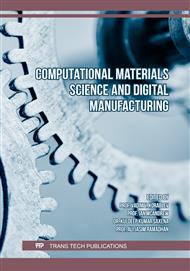[1]
L. Feng, and A. Didier, Nanocatalysts and other nanomaterials for water remediation from organic pollutants, Coordination Chemistry Reviews. 408(2020) 213180. https://doi.org/10.1016/ j.ccr.2020.213180.
DOI: 10.1016/j.ccr.2020.213180
Google Scholar
[2]
K.H.W. Johnny, K.T. Hong, Y.L. Sie, Y. Pow-Seng, K. D. Michael, Potential and challenges of enzyme incorporated nanotechnology in dye wastewater treatment: A review, Journal of Environmental Chemical Engineering. 7(4) (2019) 103261. https://doi.org/10.1016/j.jece. 2019.103261.
DOI: 10.1016/j.jece.2019.103261
Google Scholar
[3]
B. Dalila, B. Zoubir, B. Othmane, H. Boutoumi, H. Hamitouche, A. Aggoun, Removal of methylene blue by adsorption onto Retama raetam plant: kinetics and equilibrium study, Chem J Mold Gen Ind Ecolog Chem. 11(2) (2016) 74–83.
DOI: 10.19261/cjm.2016.11(2).10
Google Scholar
[4]
A. Naghizadeh, R. Nabizadeh, Removal of reactive blue 29 dye by adsorption on modified chitosan in the presence of hydrogen peroxide, Environ Prot Eng. 42(1) (2016) 149–168. DOI: https://doi.org.
DOI: 10.37190/epe160112
Google Scholar
[5]
T.K. Sen, S. Afroze, and H. Ang, Equilibrium, Kinetics and Mechanism of Removal of Methylene Blue from Aqueous Solution by Adsorption onto Pine Cone Biomass of Pinus radiate, Water, Air, & Soil Pollution. 218(2011) 499-515.
DOI: 10.1007/s11270-010-0663-y
Google Scholar
[6]
Yagub, M.T., T.K. Sen, and H. Ang., Equilibrium, Kinetics, and Thermodynamics of Methylene Blue Adsorption by Pine Tree Leaves, Water, Air, & Soil Pollution. 223(8) (2012) 5267-5282.
DOI: 10.1007/s11270-012-1277-3
Google Scholar
[7]
Lu, J., Dai, Y., Guo, M., Yu, L., Lai, K., and Huang, B. Chemical and optical properties of carbon-doped TiO2: A density-functional study, Appl. Phys. Lett. 100(2012) 102114.
DOI: 10.1063/1.3693525
Google Scholar
[8]
Gopal, N. O. et al., Visible light active phosphorus-doped TiO2 nanoparticles: An EPR evidence for the Enhanced charge separation, J. Phys. Chem. C. 116 (30) (2012) 16191–16197.
DOI: 10.1021/jp212346f
Google Scholar
[9]
Tan, K. A., Morad, N., and Ooi,J. Q., Phytoremediation of methylene blue and methyl orange using eichhornia crassipes, Int. J. Environ. Sci. Dev. 7(10) (2016) 724–728.
DOI: 10.18178/ijesd.2016.7.10.869
Google Scholar
[10]
Mohammed, M. A., Shitu, A., and Ibrahim, A., Removal of methylene blue using low cost adsorbent: A review, Res. J. Chem. Sci. 4(2) (2014) 91–102. ISSN 2231-606X.
Google Scholar
[11]
Sharma, S., Goyal, R.P., Chakravarty, G., Sharma, A., Toxicity of tomato red, a popular food dye blend on male albino mice, Experimental and Toxicologic Pathology. 60(2008) 51–57
DOI: 10.1016/j.etp.2007.11.005
Google Scholar
[12]
Pavlidis, M., Stupp, T., Naskar, R., Cengiz, C., Thanos S., Retinal Ganglion Cells Resistant to Advanced Glaucoma: A Postmortem Study of Human Retinas with the Carbocyanine Dye DiI ,Investigative Ophthalmology & Visual Science. 44(2003) 5196–5205.
DOI: 10.1167/iovs.03-0614
Google Scholar
[13]
Sasaki, Y.F., Kawaguchi, S., Kamaya, A., Ohshita, M., Kabasawa, K., Iwama, K., Taniguchi, K., Tsuda, S., The comet assay with 8 mouse organs: results with 39 currently used food additives. Mutation Research, Genetic Toxicology and Environmental Mutagenesis. 519(1-2) (2002) 103–119.
DOI: 10.1016/s1383-5718(02)00128-6
Google Scholar
[14]
Chollom, M.N. (2014). Treatment and Reuse of Reactive Dye Effluent from Textile Industry Using Membrane Technology. A thesis submitted in fulfilment of the academic requirements for the degree of Master of Technology, Engineering Durban, University of Technology.
DOI: 10.51415/10321/1388
Google Scholar
[15]
Pajootan, E., Arami, M., Mohammad, N., Binary system dye removal by electrocoagulation from synthetic and real colored wastewaters, J. Taiwan Inst.Chem. Eng. 43(2) (2012) 282-290.
DOI: 10.1016/j.jtice.2011.10.014
Google Scholar
[16]
Khader, E.H., Mohammed, T. J., Albayati, T. M., Comparative performance between rice husk and granular activated carbon for the removal of azo tartrazine dye from aqueous solution, Desalination and Water Treatment. 229(2021) 372–383.
DOI: 10.5004/dwt.2021.27374
Google Scholar
[17]
Khalaf, I. H., Al-Sudani, F. T., AbdulRazak, A. A., Aldahri, T. and Rohani, S., Optimization of Congo red dye adsorption from wastewater by a modified commercial zeolite catalyst using response surface modeling approach, Water Science & Technology. 83(6) (2021) 1369-1383.
DOI: 10.2166/wst.2021.078
Google Scholar
[18]
Mahdi, H. M., Mohammed, T. J. and Al-Najar, J. A., Advanced Oxidation Processes (AOPs) for treatment of antibiotics in wastewater: A review, IOP Conference Series Earth and Environmental Science. 779(1) (2021) 012109.
DOI: 10.1088/1755-1315/779/1/012109
Google Scholar
[19]
Sreedharan, V., Rao, K. V. B., Biodegradation of Textile Azo Dyes, Nanoscience and Biotechnology for Environmental Applications. 22(2019) 115–139.
DOI: 10.1007/978-3-319-97922-9_5
Google Scholar
[20]
Behera,M., Nayak,J., Banerjee,S., Chakrabortty,S. ,Suraj K. T., A review on the treatment of textile industry waste effluents towards the development of efficient mitigation strategy: An integrated system design approach, Journal of Environmental Chemical Engineering. 9(4) (2021) 105277.
DOI: 10.1016/j.jece.2021.105277
Google Scholar
[21]
Shah,M. (2018). Azo Dye Removal Technologies. Austin J. Biotechnol. Bioeng 5(1).
Google Scholar
[22]
Verma, A. K., Dash, R. R., and Bhunia, P., A review on chemical coagulation/flocculation technologies for removal of colour from textile wastewaters, Journal of Environmental Management. 93(1) (2012) 154–168.
DOI: 10.1016/j.jenvman.2011.09.012
Google Scholar
[23]
Kammerer, J., Carle, R., and Kammerer, D. R., Adsorption and Ion Exchange: Basic Principles and Their Application in Food Processing, Journal of Agricultural and Food Chemistry. 59(1) (2011) 22-42.
DOI: 10.1021/jf1032203
Google Scholar
[24]
Kant, R., Textile dyeing industry an environmental hazard, Scientific Research. 4 (1) (2012) Article ID: 17027, 5.
DOI: 10.4236/ns.2012.41004
Google Scholar
[25]
Anandan, S., Ponnusamy, V.K., Ashokkumar, M., A review on hybrid techniques for the degradation of organic pollutants in aqueous environment, Ultrason. Sonochem. 67, (2020)105130.
DOI: 10.1016/j.ultsonch.2020.105130
Google Scholar
[26]
Hanafy, H.,. Adsorption of methylene blue and bright blue dyes on bayleaf capertree pods powder: understanding the adsorption mechanism by a theoretical study. J. Mol. Liq. 332, (2021) 115680.
DOI: 10.1016/j.molliq.2021.115680
Google Scholar
[27]
Yu, S., Cui, J., Wang, J., Zhong, C., Wang, X., Wang, N., Facile fabrication of Cu(II) coordinated chitosan-based magnetic material for effective adsorption of reactive brilliant red from aqueous solution, Int. J. Biol. Macromol. 149, (2020) 562–571. https://doi.org/10.1016/j.ijbiomac. 2020.01.285.
DOI: 10.1016/j.ijbiomac.2020.01.285
Google Scholar
[28]
Mouhtady, O.; Obeid, E.; Abu-samha, M.; Younes, K.; Murshid,N. Evaluation of the Adsorption Efficiency of Graphene Oxide Hydrogels in Wastewater Dye Removal: Application of Principal Component Analysis, Gels. 8, (2022) 447. https://doi.org/10.3390/ gels8070447.
DOI: 10.3390/gels8070447
Google Scholar
[29]
Rehman, M.S.U., I. Kim, and Han J.I., Adsorption of methylene blue dye from aqueous solution by sugar extracted spent rice biomass, Carbohydrate Polymers. 90(3) (2012) 1314-1322.
DOI: 10.1016/j.carbpol.2012.06.078
Google Scholar
[30]
Mahmoodi, N.M, Saffar-D. MH., Zeolite nanoparticle as a superior adsorbent with high capacity: synthesis, surface modification and pollutant adsorption ability from wastewater, Microchem J. 145(2019) 74-83.
DOI: 10.1016/j.microc.2018.10.018
Google Scholar
[31]
Sardar, M., Manna, M., Maharana, M., Sen, S., Remediation of dyes from industrial wastewater using low-cost adsorbents. Green Adsorbents to Remove Metals, Dyes and Boron from Polluted Water, Springer. 49(2017) 377-403.
DOI: 10.1007/978-3-030-47400-3_15
Google Scholar
[32]
Szerement,J.,Kloc A.S., Jarosz,R., Bajda, T., Hersztek, M.M., Contemporary applications of natural and synthetic zeolites from fly ash in agriculture and environmental protection, Journal of Cleaner Production. 311(2021) 127461.
DOI: 10.1016/j.jclepro.2021.127461
Google Scholar
[33]
Hammood, Z. A., Tasnim F. C., and Rasha A., Adsorption performance of dyes over zeolite for textile wastewater treatment, Ecological Chemistry and Engineering. 28.3 (2021) 329-337.
DOI: 10.2478/eces-2021-0022
Google Scholar
[34]
Hung, N. V., et al., Highly effective adsorption of organic dyes from aqueous solutions on longan seed-derived activated carbon, Environmental Engineering Research. 28.3 (2022) 220116
DOI: 10.4491/eer.2022.116
Google Scholar
[35]
Naser, G. F., Dakhil, I. H., and Hasan, A. A., Organic pollutants removal from oilfield produced water using nanomagnetite as adsorbent, Global NEST Journal. 23(3) (2021) 381-387.
DOI: 10.30955/gnj.003875
Google Scholar
[36]
Zhou, Y., Gu, X., Zhang, R., and Lu, J., Removal of aniline from aqueous solution using pine sawdust modified with citric acid and β-cyclodextrin, Industrial & Engineering Chemistry Research. 53(2014) 887-894.
DOI: 10.1021/ie403829s
Google Scholar
[37]
AL-KHATIB L., FRAIGE F., AL-HWAITI M., AL-KHASHMAN O., Adsorption from aqueous solution onto natural and acid activated bentonite, American Journal of Enviromental Science. 8 (5) )2012) 510-522.
DOI: 10.3844/ajessp.2012.510.522
Google Scholar
[38]
Naser G. F., Dakhil I. H., Ali A. H. and Taha A. H., Methylene Violet Dye Adsorption Using Onion Skins: Kinetics and Isotherm Studies, IOP Conf. Series: Materials Science and Engineering. 1090(2021) 012047.
DOI: 10.1088/1757-899X/1090/1/012047
Google Scholar
[39]
Xu, Z., Cai, J. and Pan, B., Mathematically modeling fixed-bed adsorption in aqueous systems, Journal of Zhejiang University science A. 14(2013) 155–176.
DOI: 10.1631/jzus.A1300029
Google Scholar
[40]
Ramachandran, P., Vairamuthu, R. and Ponnusamy, S., Adsorption isotherms, kinetics, thermodynamics and desorption studies of reactive Orange 16 on activated carbon derived from Ananas comosus (L.) carbon, Journal of Engineering and Applied Sciences. 6(11) (2011) 15-26.
Google Scholar
[41]
Abril, D., Ferrer, V., Mirabal-Gallardo, Y., Cabrera-Barjas, G., Segura, C., Marican, A., ... & Valdés, O.. Comparative Study of Three Dyes' Adsorption onto Activated Carbon from Chenopodium quinoa Willd and Quillaja saponaria. Materials, 15(14), (2022) 4898.
DOI: 10.3390/ma15144898
Google Scholar




